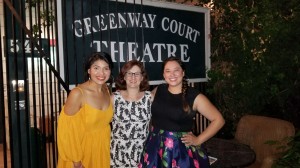Estela Garcia first read Sandra Cisneros’ coming-of-age novel, “The House on Mango Street,” in the ninth grade. She said it was the first time she had encountered anything that reflected her life growing up in South Los Angeles.
Now, the alumna plays the story’s main character, Esperanza Cordero, in the Greenway Court Theatre’s production of the book’s adaptation, which opened Friday and runs until Oct. 28. Garcia acts alongside MFA alumni, Miebaka Yohannes and Israel López Reyes, who play various male roles including Esperanza’s brothers and love interests. The actors frame Esperanza’s journey into adulthood in inner-city Chicago, while drawing influence from their own lives to shape the female-centric narrative.
The adaptation consists of 32 vignettes during the 90 minute production. While the actresses playing younger and older Esperanza are on stage together for the entirety of the play, Yohannes is on stage for a smaller number of scenes and only speaks for half of his stage time, he said.
“The play is really centered around younger Esperanza and older Esperanza and it is in opposition to the majority of plays that are written or produced in our time,” he said. “The central figures are the women, and the men sort of have to satellite.”
While he performs during half the production, Yohannes plays important male figures that surround Esperanza and the other women in her community, such as a Puerto Rican immigrant. They serve to accentuate the events the female characters are experiencing, Yohannes said.
Yohannes plays Sire, a man who observes Esperanza from a distance with mild interest. They do not speak, but Esperanza narrates the scene, describing the wordless encounter as the first time she’s been noticed by a boy, whom her parents warn against.
Garcia said her own parents, who grew up in a small town in Mexico, were protective of her growing up. When talking to boys in middle school, she said she would think back to her mother’s warnings.

In another scene, Yohannes plays a man in Esperanza’s community who has been saving up money to bring his wife, Mamacita, to Chicago from Puerto Rico. When Mamacita finally arrives, she finds adjusting to the new country difficult as she cannot speak English. One day, she asks her husband when they can go back home, to which he brusquely replies that they are home. The scene serves to frame Mamacita’s story and the hardships she faces as an immigrant and the difficulties she experiences when moving to a country where she doesn’t speak the language, Yohannes said.
“You can do all of the right things as it relates to working and trying to build a home, but for some people it’s just never the same,” he said. “What support is there for these women?”
In between scenes, the male actors do not switch costumes but instead differentiate vocal and physical components. López Reyes said he uses a lower register of his voice when playing an older man, and occupies a brighter, higher register when playing a younger character such as Esperanza’s brother, Carlos Cordero. Through his physical gestures, he portrays Carlos as a young boy by being quick on his feet and portrays older characters by walking with an intentionally slower gait.
“(The men) have a wonderful opportunity to play various different male roles in this young woman’s life,” he said. “Not just her brother, but her father, her other brother, her first dance, her first kiss, we get to play a multitude of these masculine roles that have nuance in them, that are very different from one another.”
When preparing for his roles – which include Sire, a young schoolkid and Esperanza’s brother – Yohannes said he was partially influenced by his personal observations growing up in the urban environment of New York City.
He said his previous experience working construction informed the beleaguered movements of a hardworking man while he instilled his schoolchild role with the excited energy he remembers from visits to the playground.
Garcia also drew parallels between her own life and that of her character, Esperanza, whose story begins with her parents purchasing a house on Mango Street. Garcia said soon after she was born, her own parents were able to buy a house after moving from apartment to apartment.
“There is that sense of having a childhood home, with it’s quirks, and it’s not perfect,” she said.
She said she also relates to themes in one of the 32 stories, “Those Who Don’t,” which analyzes the perceptions of a community from the viewpoint of outsiders. Growing up in South Los Angeles, Garcia said she would receive pushback from people outside her neighborhood, driven by misinformed fears of its reputation. Despite the stereotypes, Garcia said she embraces the diverse, hardworking people she’s met from all walks of life in her community, much like Esperanza does in the story.
It’s really an experience that is connected to my neighborhood, myself and the people that I love and that I’ve watched,” Garcia said. “It’s not very far away from who I am and what I’ve grown up with.”
